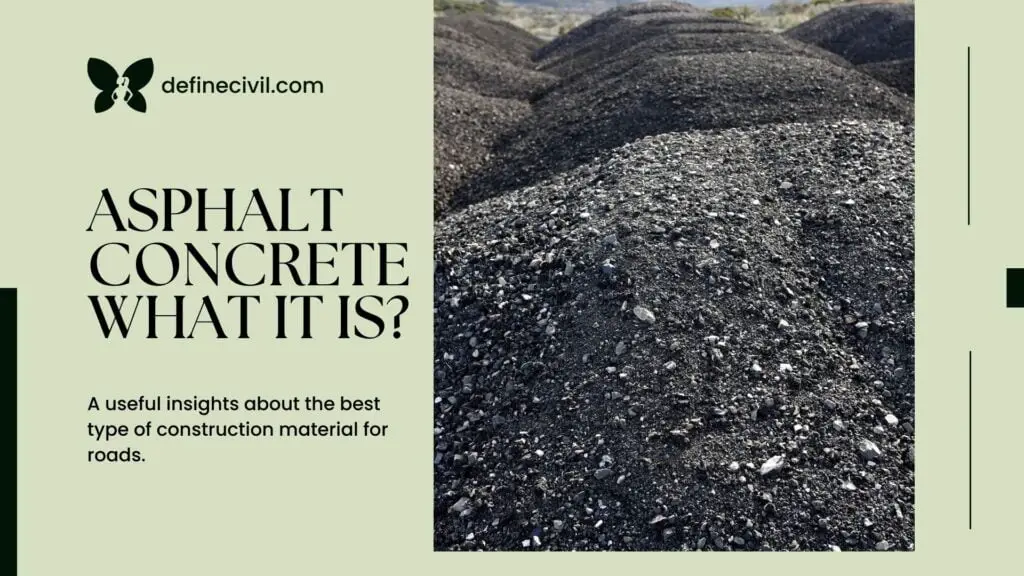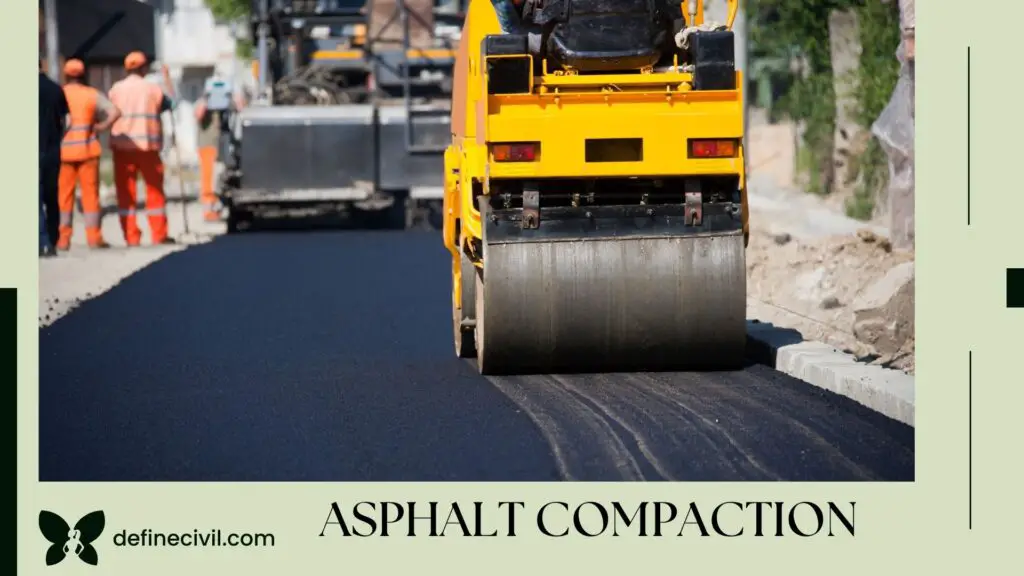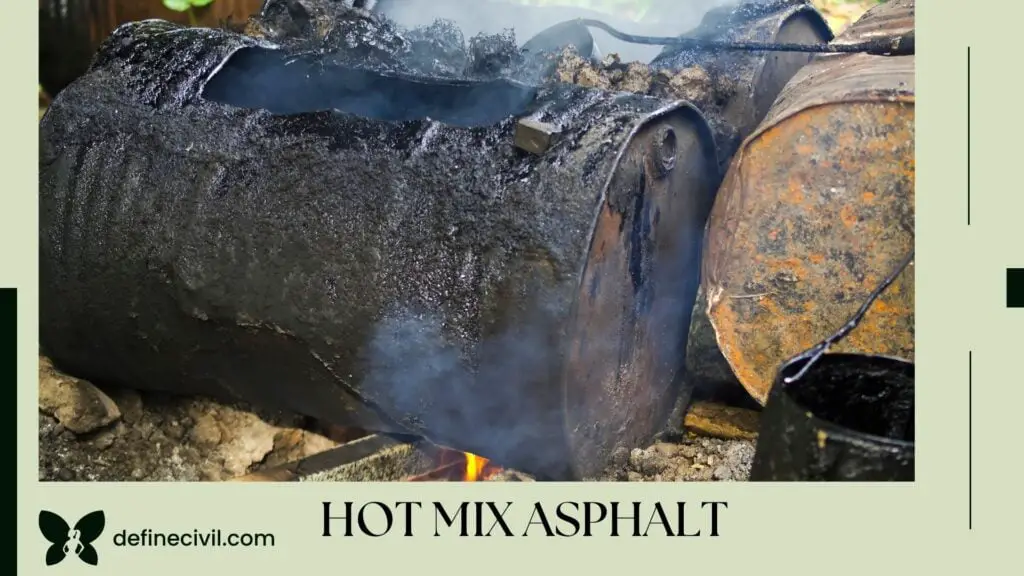Asphalt concrete also known by the name of blacktop or flexible asphalt which is generally made by mixing different materials like coarse aggregate, fine aggregate, filler and the binding material.
It is a stabilized granular soil that acts as a durable water and abrasion-resistant structure. It comprises of sand or well-graded aggregate mixed with 3 to 10% bitumen.
The coarse and fine aggregate include stones of varying size while filler material is used to fill the pores left between them.
The binding material is used to bind the aggregate and make it a homogeneous mass. Bitumen is used as a binding material in asphalt concrete. The materials are mixed at specified temperature and then molded into layers and then compacted by means of rollers.
What is asphalt concrete?
Asphalt concrete is used for the construction of roads, core of embankment dams, parking lots and airport roads. The preparation of asphaltic concrete is different for different types of projects. The percentage of each material is specified for various conditions in design manuals which are followed worldwide.
Difference between concrete and asphaltic concrete
When someone talks about concrete, he or she usually is referring to Portland cement concrete that we call as plain cement concrete. However, in asphaltic concrete or asphalt concrete, we’ve taken the word concrete because of its meaning. The word concrete means something solid or sturdy.
So, here the word concrete is synonymous to the conventional concrete that is made with Portland cement. However, asphalt and asphaltic concrete are two of the same things. We use bitumen to bind aggregates just like Portland cement binds in plain cement concrete.
But in asphalt concrete, we never add water and there’s no such thing as hydration reaction or setting. To make or batch asphalt, we follow and mix the ingredients by following the job-mix formula. It is same as that of mix design.
After mixing the ingredients, we add bitumen by melting it to high temperate. The bitumen coats the aggregate and sand. Once we compact this matrix, it forms a solid material that can withstand wearing and harsh actions.
Also Read: Difference between Flexible and rigid Pavement (Fully EXPLAINED)

Types of asphalt concrete
Hot Mix Asphalt
Hot mix asphalt is made by following the design manuals and heating various fine and coarse aggregate with filler and then adding suitable percentage of bitumen or asphalt. The mixture is usually made at 150C temperature and then transported through trucks at site.
The asphalt concrete is then placed in hoppers of paving machines and machines lay it on base of road. After laying rollers are used to compact the asphalt concrete layers.
Warm Mix Asphalt
Warm mix asphalt is produced by the mixing of same material. The only difference is that the difference of mixing temperature. In case of HMA the temperature of asphalt concrete is 150 While the temperature of Warm mix asphalt is less. This factor benefits in many ways one is durability and it also reduces cost.
Cold Mix Asphaltic Concrete
Cold mix asphalt is made mixing of aggregates, fillers and bitumen at ambient temperature. It does not require heat to made. It is prepared by simply mixing the aggregate and binding material. Cold mix asphalt is mostly used for repairing and rehabilitation purposes.it is used to fill the potholes, depressions, and utility cuts.
Cutback Asphalt Concrete
A cut back asphalt is made by adding petroleum products such as kerosene or other light petroleum products. Petroleum products are highly volatile and are added to make asphalt or bitumen less viscous. The decrease in viscosity makes the mixture easy to work and compact.
A cutback asphalt concrete is a mixture of cutback asphalt which is used as binder and it includes bitumen or asphalt and petroleum product while mixture include aggregate and filler. They are mixed in suitable proportions and lay on base layer.
The petroleum product is volatile, so it evaporates and binding material is left with aggregate which is pavement wearing course.
Also Read: Water Bound Macadam Road – WBM – Base Course – Specification – Procedure
Mastic Asphaltic Concrete
Mastic asphalt is formed by heating hard grade blown bitumen at high temperature.it is heated until we get a high viscous bitumen liquid. It is used for pavements, roofing and flooring to protect the buildings from ground moisture.
The mastic asphalt concrete is formed by adding the high viscous bitumen or asphalt with specified proportion of graded aggregates and then mixture is cooked for a period of 5-6 hours in a mixer and transported to site. It is then laid on site and compacted with the help of rollers.

The main difference between asphalt concrete and mastic asphalt is that the bitumen content in mastic asphalt is more which bind the aggregate closer together and also helps to keep water out. The main benefit of mastic asphalt concrete is that it provides better protection from water and make the pavement layer impervious.
Also Read: Mastic Asphalt Flooring (Preparation, Construction Process)
Advantages
Economical
Asphalt concrete is made by composite material which is easily available.it is economical and require less cost as compared to concrete pavements.
Time Saving
Asphalt concrete is formed by mixing the material and then it transports to site, placed, compacted with rollers and ready for use after few hours. While concrete pavements take time to develop adequate strength.
Imperviousness
Asphalt concrete pavements uses bitumen as binder which is highly impervious. It prevents water from seeping and made of highly impervious material which protect the pavement top and lower layers.
Also Read: How many yards are in a ton of gravel? (with Online Calculator)

Disadvantages
Deterioration and Cracks
Asphalt concrete deteriorate and different type of cracks can develop due to overloading and improper construction practices.
Less Durability
Asphalt concrete pavements are less durable due to weather and environmental effects. In summers when there is a high temperature the asphalt concrete become soft due to which it creates stresses and depressions in pavement. It is more effected by environmental conditions.
Heavy equipment Requirement
Asphalt concrete pavements are not formed by manual or simple method. They are formed with the help of heavy machinery such as mixers for production of asphalt concrete, trucks for transportation, paving machines for laying and rollers for compaction of layers of asphalt concrete.
Cost of asphaltic concrete
Asphalt concrete driveways are way too cheaper than concrete and has superior riding quality. That’s why a lot of homeowners prefer asphalt driveways over concrete.
However, the prices of asphalt tend to fluctuate with the crude oil prices in international market. In contrast to concrete driveway cost between $5 to $7 per square foot, the price of asphalt driveways is $2 to $4 per square foot.
A driveway of a normal size house will cost as follows for different materials:
- Gravel driveways – $1,500
- Concrete driveways – $4,500
- Asphalt driveway cost – $4,000
Anyhow, asphalt concrete driveways do need repeated maintenance.
Also Read: Rigid Pavement – Types & – Stresses – Design – Components

Mix Design
The mix design fundamental of asphalt concrete is bit different than that of normal concrete. Marshall mix design procedure is used to determine the optimum combination of aggregate and asphalt binder.
The process of mix design helps you in determining the type of aggregate, and asphalt binder to use.
In normal mix designs, we use 5 to 10 percent of asphalt cement whereas, 90 to 95 percent of total mixture is aggregate. We batch the asphalt concrete by weight.
Marshal Mix design method was a result of studies by Bruce Marshall, who was an engineer in Highway Department of Mississippi. He made a procedure that involves the selection of asphalt binder content after comparing that with minimum stability and range of flow values.
Love the read? Don’t forget to signup for our newsletter as we share useful insights about construction and civil engineering.



















